From director David Bruckner comes The Night House. Reeling from the unexpected death of her husband, Beth (Rebecca Hall) is left alone in the lakeside home he built for her. She tries as best she can to keep it together – but then nightmares come. Disturbing visions of a presence in the house calling to her, beckoning her with a ghostly allure. Against the advice of her friends, she begins digging into her husband’s belongings, yearning for answers. What she finds are secrets both strange and disturbing – a mystery she’s determined to unravel.
“A DECONSTRUCTED GHOST STORY”
THE NIGHT HOUSE is a gripping mystery, creepy supernatural thriller, and a chilling ghost story. Director David Bruckner describes his film as “both a ghost story with shades of gothic romance, and a portrait of a deeply troubled marriage. It’s a mysterious and harrowing tale of unraveling; a labyrinth that you enter at your own peril.”
Bruckner has always been attracted to the horror genre. His first film, THE RITUAL, as well as his earlier anthology work, have all explored themes of both supernatural and psychological fear. The same is true of THE NIGHT HOUSE’s writing team, Ben Collins and Luke Piotrowski, whose first film, SUPER DARK TIMES, explores paranoia and violence. When it came time for the pair to think about who could direct their script, Bruckner was an obvious choice.
“David is a friend, and we always had him in mind for this movie, believing that he could bring terror to life in a unique way,” says Collins.
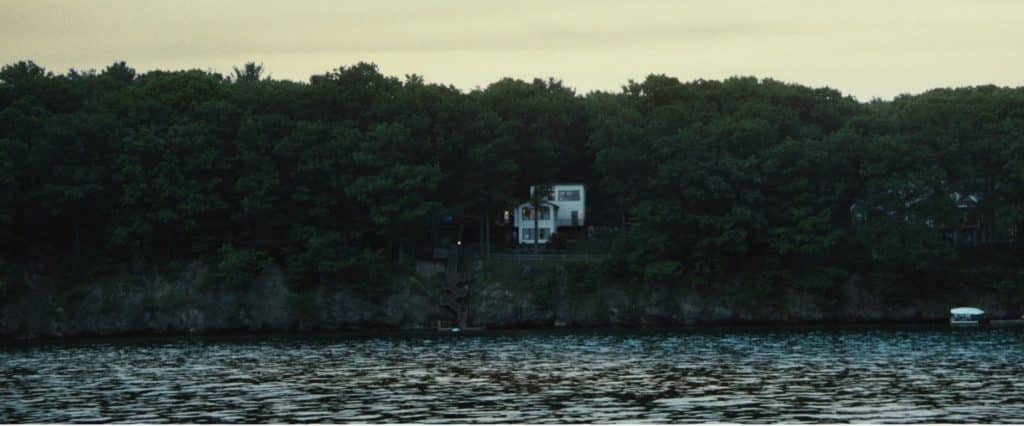
In THE NIGHT HOUSE, writers Collins and Piotrowski have written a supernatural puzzle that is slowly unlocked by a combination of demons and duplicates. Producer Keith Levine says, “THE NIGHT HOUSE is a descent into madness through the classic lens of a haunted house film.” Producer David Goyer adds, “What’s particularly scary about it is that the forces attacking Beth are exploiting her grief – using that wound to enter her world, and Rebecca’s tour-de-force performance really solidifies it all.”
Bruckner has a flair for creating tension, dislocation and sustained eeriness. The film leaves sinister clues throughout; an undecipherable suicide note, multiple photos of unknown women, reverse architectural plans, and a disturbing sculpture found in a secret location. Editor David Marks says, “I think of THE NIGHT HOUSE as a deconstructed ghost story. There’s a solitary, eerie atmosphere that we might expect in a genre movie. But in this case, it’s often the result of Beth seeking out the thing that frightens her rather than running from it, which creates opportunities to subvert the usual genre expectations.” Rebecca Hall, who stars as Beth adds, “Something that certainly drew me to the character is that she’s being haunted but is witty and dangerous and you don’t sit there going get out of the house! Because she’s saying ‘this is my house. Come and get me. Come on!’”
EMOTIONS RUN WILD
THE NIGHT HOUSE tackles themes of grief, depression, self-destruction, and the sacredness of relationships. Director Bruckner says, “the film explores the many ways we affect one another in a relationship; how vulnerable we can be to each other’s demons and the facades we maintain.”
When Collins and Piotrowski began the script, they were initially inspired by the main character’s specific circumstances more than anything else. Collins says, “the story explores the universal themes of mortality and the afterlife, whether you can ever truly know someone, the tendency people have toward darkness and self-destructive behavior, depression, anxiety.” Piotrowski adds, “For me, it’s always been about the seductive allure of dark thoughts. Lying awake at night, when my mind starts to wander and I’m thinking, this is it; this is all there is.” Piotrowski continues, “I find that sometimes, especially in the wake of hardship or tragedy, people want to feel bad. They need to. To wallow and wrap themselves in their pain. It’s better than feeling nothing. Beth loved her husband. She lost him. Now, against her better judgment, she finds herself falling for the absence of him.”
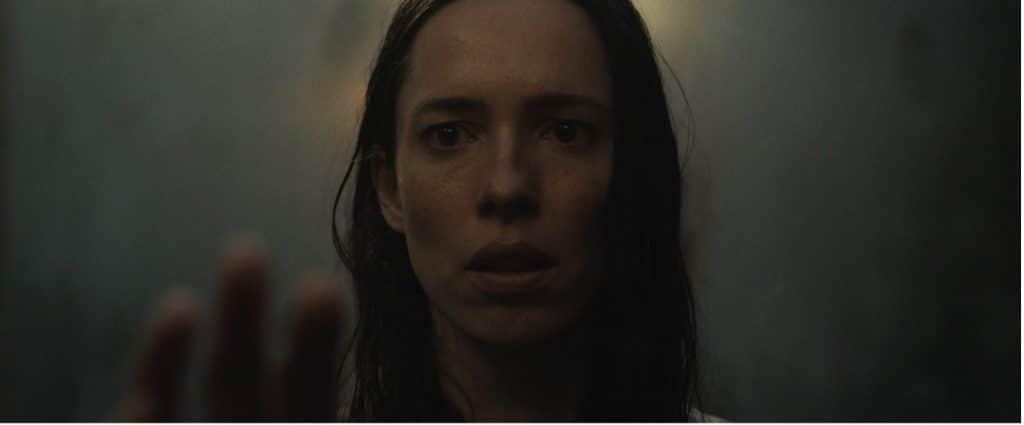
Producer Levine describes the film’s theme by asking the question, “Do we truly know our partner as well as we think we do?”
Hall adds, “It is unthinkably complicated and hard. In Beth’s case she was left to wonder if she ever knew the man she was married to. It takes that idea and pushes it to extremes.” She continues, “And ultimately, the film is about watching a woman come to terms with something life destroying and working out how to accept it, let it go and survive it.”
Editor Marks says, “An important idea in the film is that there may not be a solution to the problems we’re coping with. However, we can find comfort in the support of our loved ones, knowing we’re not struggling with these problems alone.” He continues, “Because Beth is seeking out an entity, it inherently creates a sense of uneasiness and suspense over what she might find. And the more we care for Beth, the more heightened the suspense.”
DIRECTOR’S STATEMENT
Something about Ben Collins and Luke Piotrowski’s script for THE NIGHT HOUSE lingered. Something unsettled me and I couldn’t put my finger on it. As I sought to order the conflicts and the metaphors, dig into the mechanics of the story and what my responsibilities would be as a director, I continually got lost in the subterranean regions of the narrative, which was as confounding as it was exciting.
On the surface, there was a compelling mystery about one woman’s recently deceased husband and the question of whether we can ever truly know our loved ones. There was the awkwardness of grief, and the responsibilities we have for one another in times of emotional peril. And, of course, there was the ghost story; the kind that plays fast and loose with haunt tropes in the way that any horror fan would have a blast running with.
But no matter how I approached it, a restlessness remained. I saw it in the protagonist as well. Beth was feverishly confrontational, interrogating the world around her in a way I understood but could barely keep up with. Often, I felt less like I was in her shoes and more like I was watching someone I cared about teeter on the edge of a cliff. Rebecca Hall would have a way with this on set. Given our tight timeline, we often ventured into moments guided only by gut, not knowing what Beth was going to do next.
It’s possible that there was nothing there at all. That I was simply infected with the subject matter itself. The story was like a labyrinth that you enter at your own risk, a harrowing tale of unraveling that carried at least a few dark, quiet truths I couldn’t ignore. As we approached the shoot, my only choice was to embrace discord and revel in the contradictions. Aspects of it would forever remain elusive to me.
David Bruckner, Director
DRAWING INSPIRATION
Many of Bruckner’s all-time favorite films are themed around a strong and complicated female protagonist. Bruckner says, “I love that you can use cinematic conventions to portray the inner workings of a character’s psyche. Being unable to understand what’s real is simply more frightening than the thing that’s out to get you.” He was most influenced by films such as REPULSION, BLACK SWAN, PERSONAL SHOPPER and THE BABADOOK. “I also found a lot of inspiration from great horror novels like THE TURN OF THE SCREW and HOUSE OF LEAVES, both of which deal with similar kinds of madness,” says Bruckner.
Rebecca Hall also drew inspiration from several notable classics, “Some of my favorite films of all time are in this genre even though I do not consider myself an outright horror film fanatic. ROSEMARY’S BABY, THE SHINING, a French film called LES DIABOLIQUES, CAT PEOPLE to name a few. And when I was a kid, I loved a film called THE HAUNTING directed by Robert Wise.”
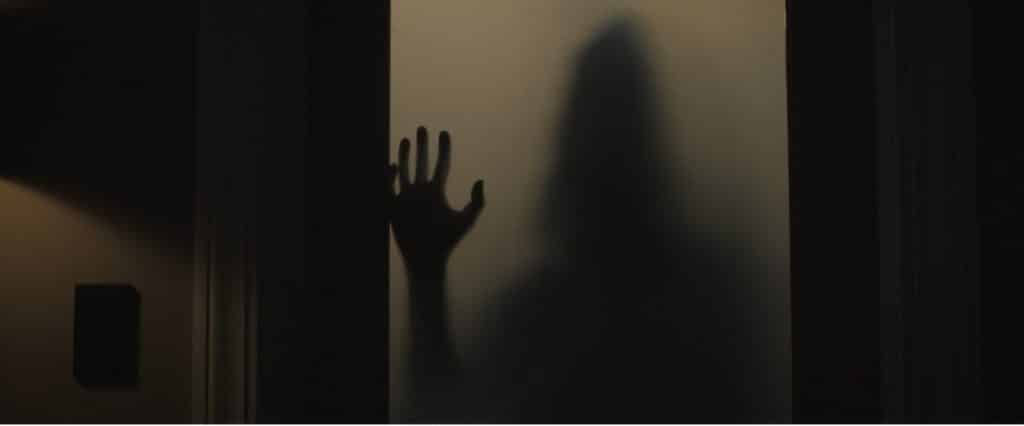
Actor Evan Jonigkeit, who plays Owen says, “In this genre, there are so many terrific female performances, and I may be biased but, Rebecca’s performance in this film is up there.” Actress Stacy Martin adds, “What I find interesting is that female led suspense films seem to give more space for mystery and the supernatural. And it’s one of the film genres that give actresses a platform to really delve into a character in ways other genres sometimes struggle to accomplish.” Actress Sarah Goldberg agrees, “I loved CARRIE and CACHE. SAFE is another one. I’m a fan of any female driven film.”
Director Alfred Hitchcock is the godfather to many of the themes that are explored in THE NIGHT HOUSE. Producer John Zois says, “From the idea of exploring our dreams in SPELLBOUND to navigating in and out of a dream-like world in VERTIGO and, of course, the existence of a malevolent force like in REBECCA, Hitchcock has given so much to the space that there will always be fingerprints of his on films of this nature.”
A MYTHOLOGY BLUEPRINT
Though the specific mythology in THE NIGHT HOUSE was largely invented by screenwriters Collins and Piotrowski, it was inspired and shaped by actual mythology – specifically Welsh turf mazes and an Egyptian voodoo doll from the 4th Century A.D. currently housed in the Louvre. Welsh shepherds built simple mazes called “Caerdroia” on hilltops to perform ritual dances. Caerdroia literally translates to “Walls of Troy”, which Piotrowski explains “is a reference to the city of Greek myth whose streets were simple enough for the enemy to enter, but ultimately too complex for them to find their way out. This fit nicely with the image of the reverse floorplan, a concept we knew we wanted to incorporate into the film from the start.”
On the topic of turf mazes, Piotrowski explains “the labyrinths served as a unique and tangible means of spell craft, the ambulatory equivalent of a chant. The idea that space or movement through space could have just as much ritual power as ‘magic words’ was intriguing.”
“We knew we wanted Owen to have attempted some sort of ‘binding spell’ to contain the sinister outside influence” said Piotrowski. “Some cursory research turned up the image of the voodoo doll – ‘The Louvre Doll,’ a clay woman pierced with 13 pins. It’s so striking, so immediate and so thematically rich. Beth is a woman bound by her doubts and fears after all.”
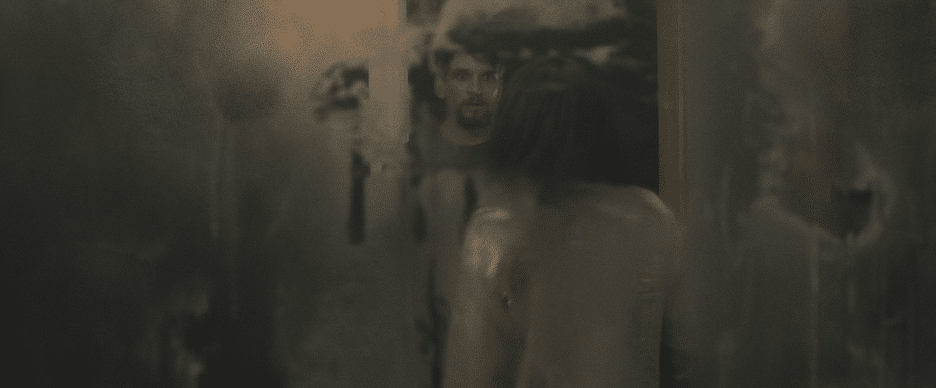
“There was constant effort to balance the film’s metaphorical interpretations with a more literal mythology,” Director Bruckner adds. “The idea of using decoys of both Beth and her home to trick the Entity away from its target fell within various magical traditions.”
Ultimately, the deeper meaning of these mazes became the driving force behind the irony of the house itself. “A maze built to confound malevolent forces, and your own home in the aftermath of tragedy as a maze that confounds you. The space is familiar but it’s wrong. Owen built a house to lose what was haunting him, but left Beth lost and haunted in the house he built for her,” says Piotrowski.
THE NIGHT HOUSE: A LITERAL LABYRINTH
The film’s eponymous set is central to its haunting story, so a huge challenge of the film was the design of the house itself. Bruckner explains, “As Beth begins to question everything in the wake of Owen’s death, who he was and who they were together, his architectural constructions evolve. We see the idyllic lakeside home turn into an uncanny reverse structure across the lake, only to descend into a literal labyrinth as Beth gives in to madness.”
To accomplish this, the filmmakers and crew first established the house on location, allowing the audience to feel the space grounded in reality. But as the story advances, they built rooms on stages where they could expand the dimensions and alter the geography. Bruckner explains, “The effect is like something from a nightmare, where the room you’re in is the same, but different in ways you’re not completely certain of.”
Piotrowski says, “The best genre stories use elements of the fantastic to illustrate relatable concepts or emotions. We’ve all been in The Night House at one time or other. We’ve all felt the sense of dislocation. As such, we knew the house had to have character. To be recognizable. And, a place Owen built full of his things. Like Owen himself, the house becomes a bit of a mystery to Beth. What is this place I’ve been living in? And, in the end, who’s really haunting the place? Him or her?” Producer Goyer adds, “The house is both a monument to Owen’s love and, when we introduce its mirror image, a monument to the secrets and darkness he was harboring.”
The house, in this case, takes on an ominous life of its own – integral to the plot and the unraveling mystery. Zois says, “It becomes clear that this is not a safe space and being there is a hurtful reminder to Beth of the life she has lost.”
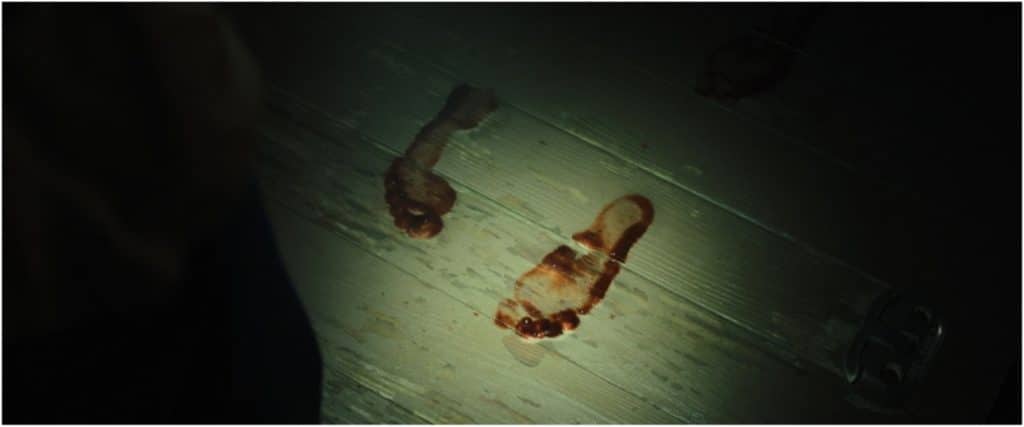
Set design is extremely important in the film as the three houses (Beth’s finished house, Owen’s under-construction house and The Night House) serve as their own characters. Zois says, “Each house reveals clues about what is happening, but none of them on their own can show the full picture. Beth’s survival depends on piecing it together.”
Actor Jonigkeit adds, “The set and locations really inform the story and the maze or labyrinth of logic and helps to put you in the off-centered reality that Beth is living through.” Hall adds, “the film is nearly entirely inside the house, so it helps to build out the character of it. Understanding the geography of the space and the furniture and know all these things. And then we would shoot scenes and essentially flip the entire room. Suddenly the couch that you are used to being here would be over there. Or something would be slightly elongated or larger, it was disorienting in the correct way because it’s disorienting for Beth.”
To craft the unsettling atmosphere, the crew faced a few challenges during production. “The house was not production friendly at all, so we went in knowing there would be enhancements by VFX,” says Cinematographer Elisha Christian. “We shot on Skaneateles Lake in New York, which is large enough to have waves on windy days. The water was also about 40 degrees F, so no one wanted to get in! The lake was a giant mirror, so as soon as the sky started to light up at dawn, it got bright, so we had to work quickly on the night scenes.”
Another challenge was figuring out an original way to deal with the “mirror logic” between the main house and Night House which production designer Kathrin Eder found to be a lot of fun. Eder says, “The biggest challenge was to build the Night House interior for the climax in the movie since David wanted the house to become a maze that Beth loses orientation in. It was a big build.”
Eder adds, “We came up with an entire backstory of how Owen went about designing the House by the lake. The key theme became bringing nature inside. We ended up using materials and colors that are native to the finger lakes region, such as slate stone, wood, deep greens, luminescent blues and neutral colors. It was very important to us to portray the house as an integral representation of the relationship between Beth and Owen. We focused on implementing more masculine features to give the audience a persistent feeling of Owen’s presence.”
REBECCA HALL AS BETH IN THE NIGHT HOUSE
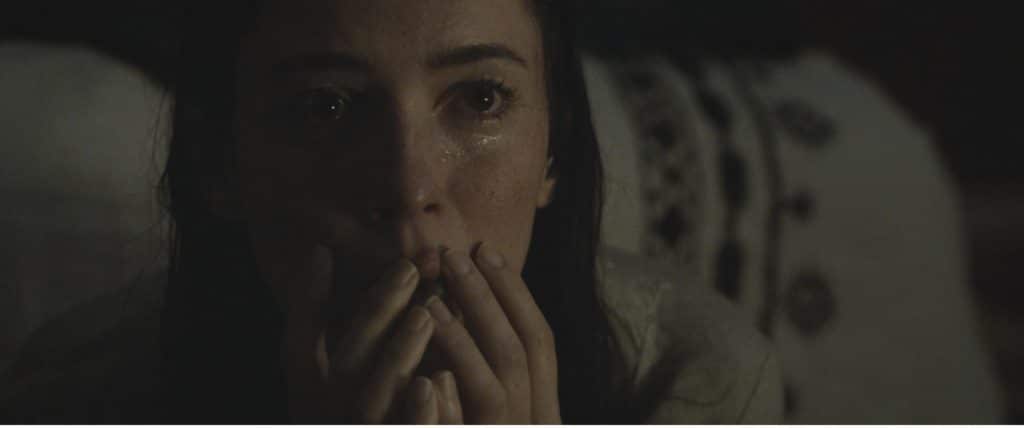
“Rebecca had an uncanny ability to internalize all the restless aspects of Beth and wield them in a way that seemed effortless. The character swings wildly from confrontation and fatalistic wit to extreme vulnerability and a yearning for connection, often several times within the same scene. It was a high wire act, and one that required a lot of trust and fearlessness on Rebecca’s part,” says director Bruckner.
During the development of the script, the team at Phantom Four was particularly drawn to the edginess and tenacity of the character of Beth. “In Rebecca’s performance, we see both pain and tragedy,” says Piotrowski. “No one else can be as simultaneously funny, intimidating, wounded and relatable.”
Acting by herself was no small feat, Hall adds, “there was a physical aspect to it that was very intense, having to imagine the physical effects and the ‘entity’, and then contorting my body in certain ways to deal with that.”
Hall goes on to explain, “As an actor, I was a little scared because it is essentially a one-person show. There are wonderful supporting actors in it but a lot of it is me in a house doing things and carrying a story by myself. That’s something I hadn’t done before and found a bit terrifying in a positive way. I was intrigued to do that.”
Actor Vondie Curtis-Hall says of Rebecca’s performance, “She’s sort of a quiet storm. You can sense the storm brewing within her.”
Producer Levine agrees, “Rebecca has a unique intensity that can deliver emotion effortlessly.” Producer Zois says, “Rebecca brings incredible courage and authenticity to the role.”
BUILDING THE NIGHT HOUSE: THE SUPERNATURAL IS IN THE DETAILS
Director Bruckner and production designer Eder worked meticulously to make sure every corner of the house revealed a little bit more of Beth and Owen’s story. “We constructed a history of the marriage up to present day, focusing on the details of their daily routines to create a momentary snapshot of their lives; like a museum depicting the final days of their marriage,” says Bruckner. “The hope is to give the audience a palpable sense of Owen’s presence despite his absence.”
Cinematographer Christian says, “The film intentionally doesn’t spell things out, instead playing between being awake and in a dream state. As an audience, we follow Beth back and forth, until we don’t know what’s real anymore. The amount of alcohol she consumes throughout the story just further clouds our vision.”
The couple’s past is viewed through old home video footage that Beth watches while she drinks alone late into the night. Eder says, “We shot the video of the wedding, reception and Owen building the house on a single chip camcorder from that era because we wanted it to feel as authentic as possible.”
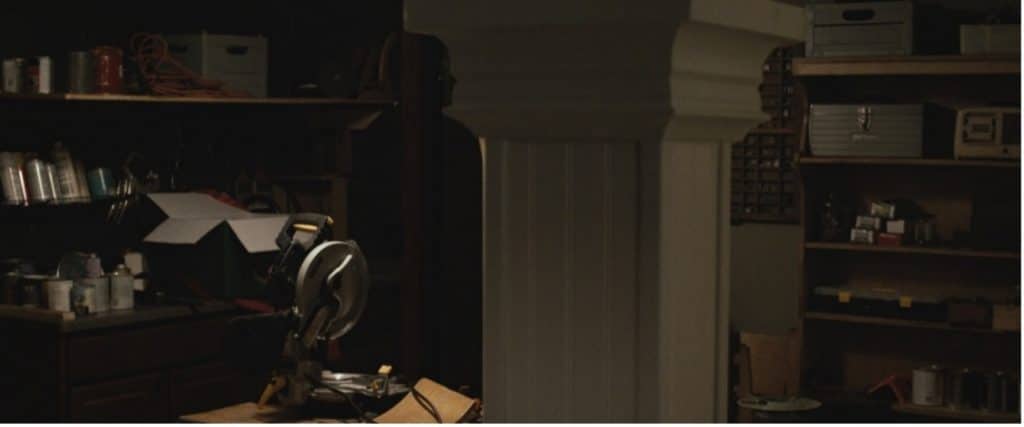
Costume Designer Samantha Hawkins describes how she saw Beth’s character, “I wanted to show Beth’s isolation and dissociation among the other characters in the ‘real world’ of the story. Beth’s palette is very subdued and never contains patterns except for one striped shirt. However, every other character that surrounds her is wearing patterns. Her friend Claire wears patterned tops, as well as everyone at the school Beth works at and her neighbor Mel,” says Hawkins. “I wanted Beth’s look to feel like a part of the design of her home, yet very different from everyone else in the outside world to further isolate her visually.”
Hawkins also researched many details for Beth’s accessories. “A flower Beth wears in her brooch when returning from her husband’s funeral is a purple anemone, that symbolizes anticipation and protection against evil,” she explains.
While editing, the team took great care to hone the timing of key moments to be as surprising as possible. Editor Marks says, “If any detail is slightly off, the tension can easily deflate, and the scare won’t work. The timing of the edit, the sound, and the music all work hand in hand to make these moments work.” He continues, “David is a master of staging scares, and works tirelessly on-set to make sure those moments are executed effectively.”
Another structural element is that there are no flashbacks in the entire film. Marks explains, “Even though so much of the film is dependent on past events, not relying on flashbacks helped keep the story streamlined and grounded in the present moment as we discover what’s happening along with Beth. I love that about the movie, but it also forced us to be creative in how we conveyed important backstory information without feeling heavy handed.”
The filmmakers tried not to stray far from our understanding of what the hauntsrepresent. Bruckner says, “I’m a big believer that you can forever refine horror beats, but it’s the underlying conflicts that get under the audience’s skin and makes them truly terrifying. If you can relate to what Beth is confronting, then the set pieces will have a greater impact.”
Bruckner explains, “Every bump in the night or vision of Owen in the architecture (or the absence thereof) was intended to tell us something about Beth’s internal conflicts. If the character journey is relatable and rooted in a reality we can grasp, then the supernatural elements of the film can go in fantastical directions.”
VISUAL EFFECTS IN THE NIGHT HOUSE: DEPICTING “NOTHINGNESS”
The filmmakers wanted the audience to have the sense that something was both-there and not there at the same time. Just as Beth wrestles with the absence of Owen, her mind begins to play tricks on her. There were a lot of discussions about how to depict “nothing”. The team termed this entity “Negative Space Man” on set. Bruckner conceived of in-camera optical illusions to effectively use the negative space. Goyer says, “They play on the notion we’ve all experienced where you wake up in the middle of the night and think you see ‘something’ amidst the shadows, then realize your eyes are playing tricks on you. But in this film, the opposite happens – what Beth thought was a trick turns out to be real.” The result is that these subtle manipulations leave the audience feeling unsteady and unsure of what they’re seeing, which is exactly the state of mind that Beth descends into.
Bruckner says, “Inspiration was drawn from forced perspective art and a popular optical illusion such as Rubin’s Vase. We built the instances on set, which required meticulous planning as the camera position and movement had to be precise for the illusion to take hold. Character animation was added in visual effects.”
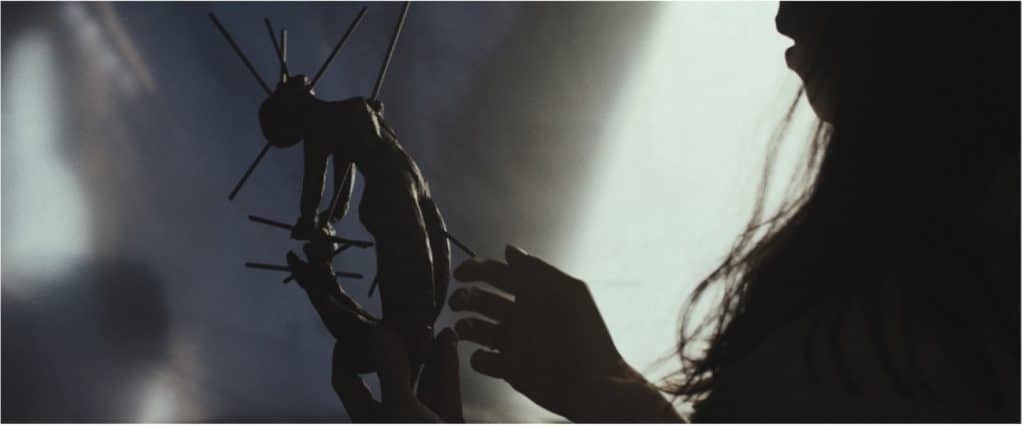
Director Bruckner hired Patrick Horvath as the Special Effects Technician. He spent hours on location and in the art department to create the “Negative Space Man,” an entity, a shadowy menace, a presence that you could feel and maybe see if you looked the right way.
Cinematographer Christian says, “Patrick was an invaluable resource when it came to bring the “Negative Space Man” to life. He figured out the specific details of the three-dimensional spacing needed so that people felt the illusion. For the sequence, David would block out the actor and camera moves in advance, and then Patrick would work out how the shape could form along a 3D axis, playing around with the depth of shapes and using some forced perspective.
Editor Marks adds, “visual effects became important in animating the environment to help bring it to life. We wanted to create the subtlest of movements, so we feel the presence of something in the room without it being obvious. It was crucial that we strike the balance of the entity being just noticeable enough but not so noticeable that the viewer is sure of what they saw.”
MIRROR HARMONIES: MUSIC AND SOUND IN THE NIGHT HOUSE
From the very beginning, the music helps set the stage. Ben Lovett’s music was crucial in crafting the story and building tension for the viewer along Beth’s journey. “Since music adds to the emotional language of any film, my goal was to elevate the subconscious conversation with the audience,” says composer Ben Lovett.
Director Bruckner adds, “Ben wanted to come on early during the script phase and develop alongside production. He created an entire soundtrack of explorations that I was then able to listen and share with other key departments. There was one track which found its way into the movie that I listened to daily during my commute to set.”
Lovett first began experimenting with how different story concepts would translate into music including the inverted architecture, mirrored floor plans, doppelgängers and repeating patterns. “I worked on musical palindromes and melodies that could be played forward and backwards and it began to evolve from there.”
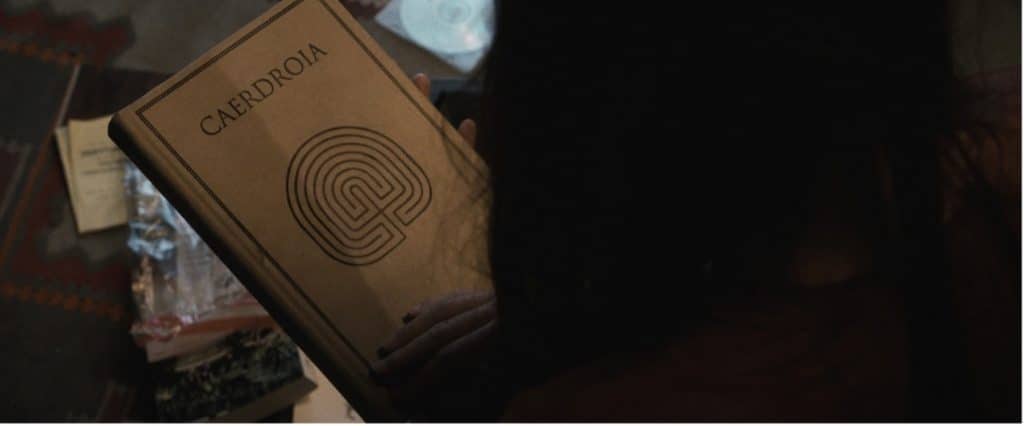
“I used a technique called negative harmony,” Lovett explains, “This involves inverting the notes of a melody so that each has a corresponding mirror note on the opposite side. That concept was employed in the wedding theme in order to turn it inside out and create a shadow harmony of the original on the darker side of the harmonic spectrum.” Richard Thompson’s “The Calvary Cross” ironically serves as Beth’s wedding song with dark and ominous lyrics. The song later startles her awake one morning following her husband’s death, providing a stark juxtaposition between the unrivaled bliss of a wedding day and of the paralyzing misery of a loved one’s passing.
Since most of the film takes place at a lake house, Lovett spent a few days on set and came away thinking about the differences of lake water versus ocean water. He explains, “Lake water is murkier and more unstable. It’s never quite still, always agitated by external forces. I wondered what that might sound like as instrumentation.” The resulting sound became a way to explore and modulate Beth’s states of anxiety.”
Lost in the limbo between denial and acceptance, Beth’s relationship with the great beyond is haunting. THE NIGHT HOUSE is a terrifying, chilling ghost story that reflects our fraught times. It’s about what frightens you most. Bruckner says, “is it the idea that ghosts actually exist, or the realization that they don’t.”
Searchlight Pictures presents THE NIGHT HOUSE directed by David Bruckner (THE RITUAL) from a screenplay by Ben Collins and Luke Piotrowski (SUPER DARK TIMES). The creative team includes producers David Goyer, Keith Levine and John Zois, Director of Photography Elisha Christian, Production Designer Kathrin Eder, Costume Designer Samantha Hawkins, Film Editor David Marks and Music by Ben Lovett.
FILMMAKER BIOS
DAVID BRUCKNER (Director) David Bruckner is an American film director and screenwriter. He got his start with the first Transmission of THE SIGNAL, a science fiction horror triptych, which explored themes of paranoia in mass media. Originally produced for under 50,000 dollars, THE SIGNAL premiered at Sundance in 2007 and went on to score a nomination for the “Independent Spirit John Cassavetes Award.” David went on to create notable contributions in other anthologies, including the AMATEUR NIGHT segment of V/H/S (2012), THE ACCIDENT segment of SOUTHBOUND (2016) and an episode of the TV adaptation of CREEPSHOW (2019). His first solo directed feature film, THE RITUAL, based on the novel by Adam Nevill, premiered at TIFF in 2017 and was released as a NETFLIX original in 2018. THE NIGHT HOUSE, his second solo directed feature film, premiered at Sundance 2020 and was acquired by Searchlight Pictures. He is set to direct the reboot of HELLRAISER for Spyglass Entertainment.
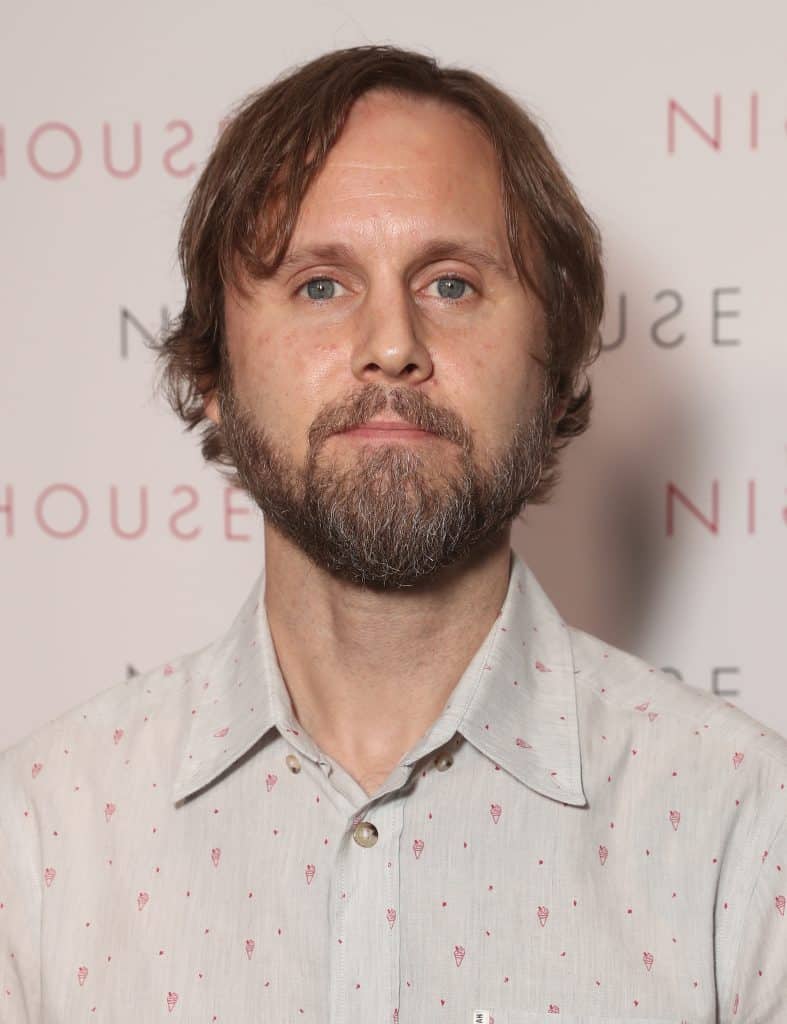
BEN COLLINS (Screenplay) Ben Collins was born in Alabama and grew up outside of Atlanta. In 2009 he moved to Los Angeles to pursue a career in film. With writing partner Luke Piotrowski, Ben balances his time, working on both studio films and more idiosyncratic, independent projects. In 2017 their film, SUPER DARK TIMES, premiered at the Tribeca film festival. The duo are fellows of the 2018 Sundance Institute’s Screenwriters Lab and returned to the Sundance film festival in 2020 for the world premiere of THE NIGHT HOUSE.
LUKE PIOTROWSKI (Writer) Luke Piotrowski was born and raised in the suburbs of Chicago before moving with his family during his sixth grade year to the suburbs of Atlanta, where he stayed until he was able to make a family of his own and move them to the suburbs of Los Angeles, where he currently resides. He’s written many screenplays in many genres with Ben Collins, his writing partner of 13 years, including the 2017 feature SUPER DARK TIMES.
DAVID MARKS (Editor) David Marks is a Los Angeles-based editor who cut the Sundance hit THE LAST BLACK MAN IN SAN FRANCISCO for A24 and Plan B and Gus Van Sant’s DON’T WORRY, HE WON’T GET FAR ON FOOT, starring Joaquin Phoenix and Jonah Hill. He was also an additional editor on Felix Van Groeningen’s BEAUTIFUL BOY starring Steve Carell and Timothée Chalamet, for Plan B and Amazon.
In addition, Marks was assistant editor on Jon Watts’ SPIDER-MAN: HOMECOMING, Michael Bay’s 13 HOURS, and was first assistant and VFX editor on Gus Van Sant’s THE SEA OF TREES. He has also worked in editorial with directors including Ridley Scott and James L. Brooks. He is originally from Utica, New York and studied filmmaking at NYU’s Tisch School of the Arts.
ELISHA CHRISTIAN (Director of Photography) Elisha Christian is a thoughtful, talented, and collaborative DP. He recently wrapped Amazon’s thriller THE VOYEURS, written and directed by longtime collaborator Michael Mohan, starring Ben Hardy and Sydney Sweeney. He also lensed the Natalie Johns documentary MAX RICHTER’S SLEEP, which premiered at Sundance 2020. He was nominated for an Independent Spirit Award for his brilliant cinematography on Kogonada’s Sundance debut COLUMBUS, starring Haley Lu Richardson and John Cho. Christian’s other credits include Netflix’s 90s comedy series EVERYTHING SUCKS! created by Ben York Jones and Michael Mohan. Christian previously collaborated with Mohan on four projects that were all brought to Sundance – PINK GRAPEFRUIT, SAVE THE DATE, ONE TOO MANY MORNINGS and EX-SEX. 9465
KATHRIN EDER (Production Designer) Kathrin Eder is an Austrian born, L.A. based production designer working in film, television, commercials and music videos. Her background in social and cultural anthropology from the University of Vienna roots her approach to story and design. Previous noteworthy projects include Nikole Beckwidth’s STOCKHOLM PENNSYLVANIA and Jason Orley’s BIG TIME ADOLESCENSE. She just competed “The Binge” and “The Ultimate Playlist of Noise” for Hulu/American High and is set to start Black Mafia Family for Starz/Lionsgate. Kathrin speaks English and German fluently, Spanish conversationally. Kathrin is wrapped with WP-A.
BEN LOVETT (Composer) Ben Lovett is an American recording artist, songwriter and composer known for crafting unconventional scores to a diverse range of films including the Netflix original THE RITUAL, Independent Spirit Award nominee THE SIGNAL, the Duplass Brothers’ survival thriller BLACK ROCK, Amy Seimetz’s award-winning noir SUN DON’T SHINE, Emma Tammi’s avant-garde western THE WIND, and the time travel sci-fi noir SYNCHRONICITYwhich earned Ben a nomination for “Discovery of the Year” at the prestigious World Soundtrack Awards. Lovett’s latest work includes the colorful taxidermy documentary STUFFED, Jim Cummings’ new tragicomedy THE SNOW OF SNOW HOLLOW, and a new collaboration with Ritual director David Bruckner on the Searchlight thriller, THE NIGHT HOUSE.
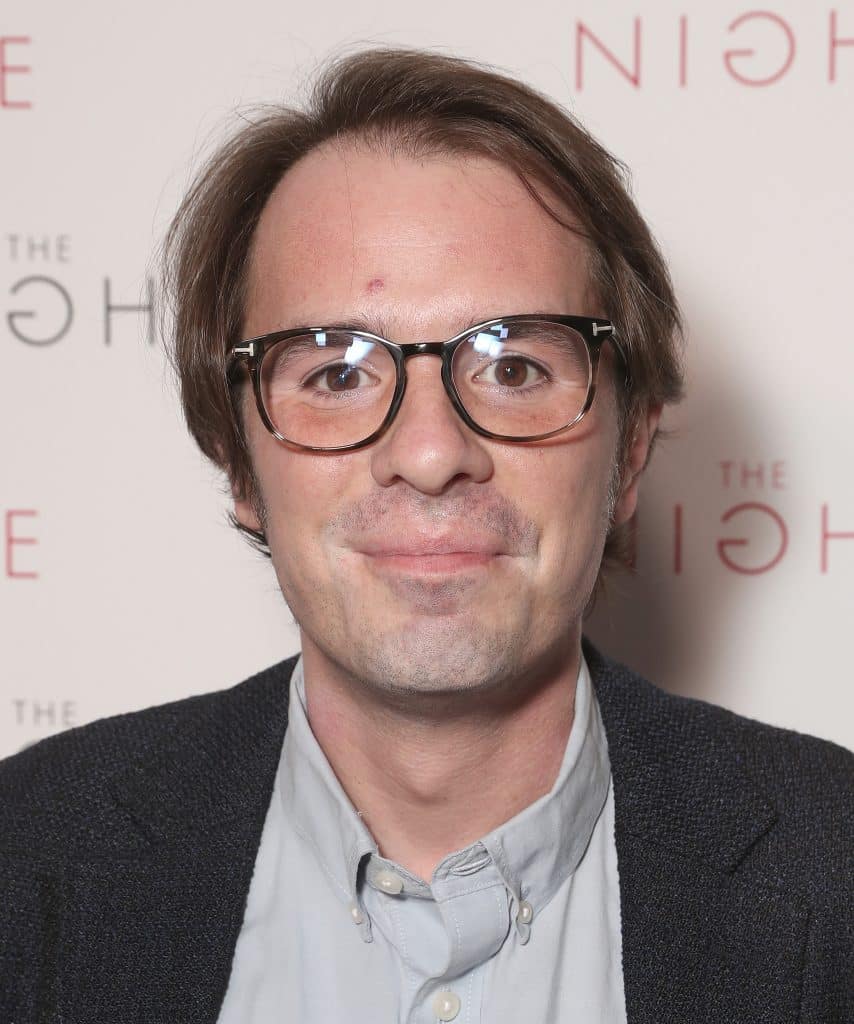
BEN LOVETT (Composer) Ben Lovett is an American recording artist, songwriter and composer known for crafting unconventional scores to a diverse range of films including the Netflix original THE RITUAL, Independent Spirit Award nominee THE SIGNAL, the Duplass Brothers’ survival thriller BLACK ROCK, Amy Seimetz’s award-winning noir SUN DON’T SHINE, Emma Tammi’s avant-garde western THE WIND, and the time travel sci-fi noir SYNCHRONICITYwhich earned Ben a nomination for “Discovery of the Year” at the prestigious World Soundtrack Awards. Lovett’s latest work includes the colorful taxidermy documentary STUFFED, Jim Cummings’ new tragicomedy THE SNOW OF SNOW HOLLOW, and a new collaboration with Ritual director David Bruckner on the Searchlight thriller, THE NIGHT HOUSE.
DAVID GOYER (Producer) David Goyer has earned a reputation for telling character-driven stories adapted from the otherworldly realms of superheroes, fantasy and the supernatural. His breakout came in 1998 when he wrote the action hit “Blade,” starring Wesley Snipes. He then wrote 2002’s BLADE II, on which he also served as an executive producer. In 2004, he directed, wrote and produced the last of the trilogy, “BLADE: TRINITY.”
Previously, Goyer scripted and collaborated with Christopher Nolan on the story for Zack Snyder’s hit action adventure MAN OF STEEL. Goyer also worked with Nolan on the mega-hit “DARK KNIGHT” trilogy, starting with the screenplay for BATMAN BEGINS. Goyer went on to team with Nolan for the billion-dollar blockbuster “The Dark Knight,” followed by the story’s conclusion in THE DARK KNIGHT RISES.
In 2002, Goyer made his feature film directorial debut with the drama ZIG ZAG, for which he also wrote the screenplay, based on the acclaimed novel by Landon Napoleon. His other directing credits include THE INVISIBLE and the hit supernatural thriller THE UNBORN.
In addition to screenwriting, Goyer made his debut in video games with the story for the smash hit “Call of Duty: Black Ops,” and penned the story for its blockbuster follow up, “Call of Duty: Black Ops 2.”
In television, Goyer’s work includes the series “Da Vinci’s Demons,” in which he served as creator, writer, director, and executive producer; “Constantine,” based on the popular DC Comics series Hellblazer; the sci-fi drama “Flashforward”; and the Syfy TV series “Krypton.” In addition, Goyer executive produced the Sundance hit, “The Birth of a Nation,” which won both the Audience award and the Grand Jury Prize at the festival.
Most recently, David produced “Assassination Nation” with Refinery29 and NEON, penned the script for the upcoming film, “Terminator: Dark Fate,” and acts as a producer on “Antlers” with Guillermo del Toro (currently in post-production). Upcoming, he will continue working with Lucasfilm’s xLAB on “Vader Immortal,” a “Star Wars” VR project, and show-run the upcoming Isaac Asimov “Foundation” series for Skydance Television and Apple, which he co-created with Josh Friedman.
KEITH LEVINE (Producer) Keith Levine currently serves as President of David S. Goyer’s Phantom Four Films, overseeing a massive slate of both TV and Film. On the feature side, Keith is prepping reboots of both HELLRAISER and THE OMEN for production, with Spyglass and Fox respectively. He is also gearing up for the spy thriller ROGUE for STX in the fall.
In his days as a studio executive at Dimension Films, he was an Executive Producer on the feature films POLAROID, 47 METERS DOWN, and AMITYVILLE: THE AWAKENING. In addition, he was involved in overseeing the production of over twenty movies including SCREAM 4, PADDINGTON, and PADDINGTON 2 among others.
Past TV credits include serving as Executive Producer on the Netflix animated series SPY KIDS: MISSION CRITICAL, and producer on MTV’s series-adaptation of SCREAM and Spike TV’s THE MIST, based on the story by Stephen King.
Keith has lived in Massachusetts, Texas, New Jersey, North Carolina, Connecticut, Georgia, New York, California and Japan.
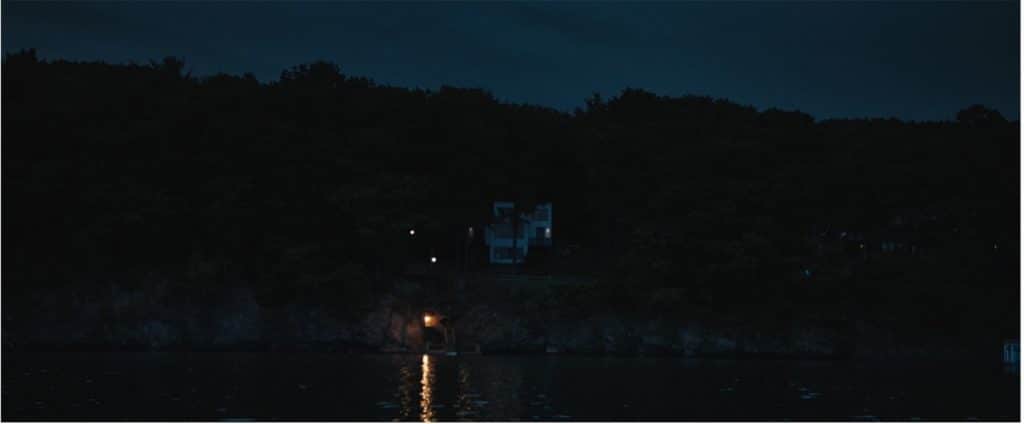
John Zois (Producer) is the Executive Vice President of Acquisitions and Co-Productions at Anton, a global content provider of high quality commercial product for multiple platforms, with offices in London and Los Angeles.
Zois oversees the company’s film and TV operations including the overall acquisition and supervision of productions. Working closely with Anton’s Founder and CEO Sebastien Reynaud, John has shepherded three new features into production last year: as producer on THE NIGHT HOUSE, starring Rebecca Hall, directed by David Bruckner; as executive producer on GREENLAND, directed by Ric Roman Waugh starring Gerard Butler produced by Basil Iwanyk; and as executive producer on Ridley Scott’s Scott Free Productions’ NAKED SINGULARITY starring John Boyega, Olivia Cooke and Bill Skarsgărd directed by Chase Palmer. In addition, Zois is currently putting together Anton’s next feature, David Slade’s COME CLOSER. Finally, Zois is working closely on Anton’s Quibi series “Curs>R” that is currently being developed.
Zois was previously Head of Acquisitions & Co-Productions at Global Road where he oversaw the acquisition of the classic family drama THE SECRET GARDEN starring Colin Firth from producer David Heyman, slated for release in 2020 through STX; and THE SILENCE starring Kiernan Shipka and Stanley Tucci, released by Netflix.
Prior to that, Zois served as SVP of Production & Acquisitions at IM Global, and VP of Acquisitions at EuropaCorp. At FilmNation Entertainment, Zois worked on a slate of films including the Academy Award® winning feature ROOM. Zois began his career at The Gersh Agency and AMC Theatres. He is a graduate of NYU’s Tisch School of the Arts.
